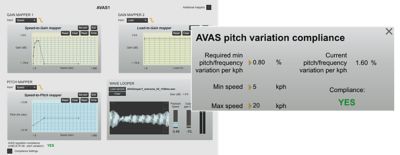-
-
Accédez au logiciel étudiant gratuit
Ansys donne les moyens à la prochaine génération d'ingénieurs
Les étudiants ont accès gratuitement à un logiciel de simulation de classe mondiale.
-
Connectez-vous avec Ansys maintenant !
Concevez votre avenir
Connectez-vous à Ansys pour découvrir comment la simulation peut alimenter votre prochaine percée.
Pays et régions
Espace client
Support
Communautés partenaires
Contacter le service commercial
Pour les États-Unis et le Canada
S'inscrire
Essais gratuits
Produits & Services
Apprendre
À propos d'Ansys
Back
Produits & Services
Back
Apprendre
Ansys donne les moyens à la prochaine génération d'ingénieurs
Les étudiants ont accès gratuitement à un logiciel de simulation de classe mondiale.
Back
À propos d'Ansys
Concevez votre avenir
Connectez-vous à Ansys pour découvrir comment la simulation peut alimenter votre prochaine percée.
Espace client
Support
Communautés partenaires
Contacter le service commercial
Pour les États-Unis et le Canada
S'inscrire
Essais gratuits
ANSYS BLOG
June 16, 2023
Acoustic Vehicle Alerting Systems (AVAS) for EVs
Cars with internal combustion engines can’t help but make a bit of a ruckus. Consider the clamor of firing cylinders, spinning belts, and mechanical friction, and it’s easy to see how the roars and rumbles of combustion have defined our expectations of how moving vehicles sound. But replace the noise of gas power with the silence of an electric engine, and suddenly the sound of driving is ready for reimagining.
What is AVAS?
Unlike internal combustion engines, there is little natural mechanical sound emitted from the engine of an electric vehicle (EV). This means that at low speeds, EVs are nearly silent, making it difficult for pedestrians — especially those with vision impairments — to know when an EV is approaching.

Ansys Sound at use inside a vehicle.
Acoustic vehicle alerting systems (AVAS) are sound generators used in EVs to alert pedestrians, cyclists, children, and other road users that a car is present. Played via loudspeakers located beneath the bodywork, these sounds are coordinated with the vehicle's real-time data to provide external auditory information on the vehicle’s speed, direction, and distance. AVAS is an important system in all electric vehicles for several reasons:
- Pedestrian safety: AVAS reduces the risk of crosswalk and other roadway accidents by producing an audible warning sound, both in drive and reverse, that alerts pedestrians to an oncoming EV.
- Sound branding: In addition to the visual aesthetics of their cars, automotive manufacturers can create a unique sound for their electric vehicles to distinguish them from other companies and improve brand recognition.
- Regulation compliance: Many countries mandate the use of AVAS in electric vehicles to improve road safety. United Nations regulations governing quiet road transport vehicles were created in 2017.

Ansys Sound software can be used to anticipate, test, optimize and validate active sound design for electric vehicles (ASDforEV).
What Do AVAS Regulations Include?
When sound regulations were first implemented for vehicles, it was to make cars quieter. But now, today’s noise standards are in place to ensure the sounds that EVs make are audible, recognizable, and relevant.
As of 2019, several nations require AVAS on all electric vehicles. While regulations vary by country and region, these mandates were created to ensure that AVAS technology meets standards for noise levels and distinguishability.
Most regulations require the vehicle to emit a continuous sound up to 20 km/h, with a volume and pitch that vary proportionally to its speed. This way, pedestrians have the feeling of how fast the car is moving just by hearing it.
For instance, UN Regulation No. 138 states that a vehicle equipped with an AVAS will not emit an overall sound level that is more than 75 dB(A). It also states that the AVAS sound frequency range will vary at least 0.8% per 1 km/h in the speed range from 5-20 km/h when driving in a forward direction.

Ansys Sound screenshots showing sound tuning (left) and acoustic vehicle alerting system (AVAS) compliance checks.
How Are AVAS Sounds Created?
To create sounds for electric cars, automotive manufacturers enlist the expertise of sound designers. Working within the automaker’s objectives and regulatory parameters, they use musical instruments, props, digital effects, and sampled sounds to create a unique acoustic experience for the brand.
But what does a brand sound like? For some car makers, the ideal sound is natural and organic, like wind and water. Others want their EVs to sound strong and cinematic while other brands prefer their EVs share the signature rumble of their legacy gas-powered models.
Creating the ideal EV soundscape requires considering how sounds (both artificial and natural) may interact at different times. Are different driving events delivering simultaneous sound information to the driver? Do these sounds complement or mask each other? When should sounds be harmonic or dissonate? What sounds already have meaning assigned? For example, a spacecraft-sounding AVAS from Jaguar had to be redesigned when tests showed people looked up at the sky when they heard it.
To account for these complexities, sound designers use Ansys Sound to anticipate, test, optimize and validate active sound design for electric vehicles (ASDforEV). This allows them to start from a baseline set of sounds, then alter the sound properties (such as loudness, pitch, and timbre) to create new sounds. They can also explore how the laws of sound change according to driving parameters such as speed, RPM, pedal load, acceleration, and torque. By hearing the sounds played in real time through the vehicle’s audio system or inside driving simulators, sound designers not only create future soundscapes, but also know how they’ll perform in real driving conditions.
AVAS example 1: soothing and harmonious
AVAS example 2: smooth and whirring
AVAS example 3: sporty and futuristic
The AVAS sound examples above were created and recorded using Ansys Sound software.
In addition to AVAS sounds for pedestrians, ASDforEV makes it possible to assess and tune other types of sounds for driver and passengers played inside the vehicle:
- Speed acceleration feedback (SAF) sounds
- Internal combustion engine (ICE) sounds
- Advanced driver-assistance system (ADAS) sounds
- Human-machine interaction (HMI), ambiance, warning sounds

Many types of sound can be controlled with Ansys Sound.
The Future of the Acoustic Vehicle Alerting System
AVAS started as a pedestrian warning system, an acoustic alert created to warn people that a moving car is nearby. But as a quickly crowding EV market pushes manufacturers to distinguish their brand and technology enables even greater audio artistry, acoustic vehicle alerting systems will continue to evolve — from the electric whir of spaceships and power lines to all-new acoustic experiences that will redefine how sound moves us.